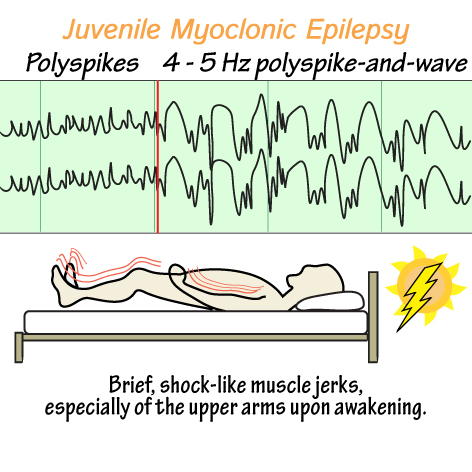Juvenile Myoclonic Epilepsy

What is Juvenile Myoclonic Epilepsy?
Juvenile myoclonic epilepsy (JME) is a type of genetic epilepsy syndrome that typically begins in adolescence and is characterized by myoclonic jerks (sudden, involuntary muscle contractions), generalized tonic-clonic seizures, and, in some cases, absence seizures.
Who's at risk for Juvenile Myoclonic Epilepsy?
JME usually affects individuals between the ages of 8 and 26, with the onset most commonly occurring during adolescence. Both males and females are equally at risk. A family history of epilepsy, particularly JME, increases the risk of developing the condition.
What causes Juvenile Myoclonic Epilepsy?
JME is primarily caused by genetic factors, with several genes implicated in its development. Although the exact mechanisms are not yet fully understood, it is believed that these genetic mutations disrupt the normal functioning of neurons and lead to an imbalance in excitatory and inhibitory neurotransmitters in the brain.
How does Juvenile Myoclonic Epilepsy start?
Juvenile myoclonic epilepsy typically begins during adolescence, although it can occur in childhood or early adulthood. The onset of JME is often marked by the appearance of myoclonic jerks, which usually occur soon after waking up. Over time, the individual may also experience generalized tonic-clonic seizures and, in some cases, absence seizures.
What are the symptoms of Juvenile Myoclonic Epilepsy?
The main symptoms of JME include:
- Myoclonic jerks: Sudden, brief, involuntary muscle contractions that typically occur in the arms and upper body, often soon after waking up.
- Generalized tonic-clonic seizures: Seizures characterized by a sudden loss of consciousness, muscle stiffening, followed by rhythmic jerking movements.
- Absence seizures (less common): Brief lapses in consciousness or staring spells, often lasting only a few seconds.
How is Juvenile Myoclonic Epilepsy diagnosed?
Diagnosing JME involves a thorough medical history, a detailed description of seizure episodes, and a neurological examination. An electroencephalogram (EEG), which records the brain's electrical activity, is typically used to confirm the diagnosis. In some cases, brain imaging studies, such as magnetic resonance imaging (MRI), may be performed to rule out other potential causes of seizures.
How can Juvenile Myoclonic Epilepsy be treated?
JME is usually treated with anti-seizure medications (antiepileptic drugs) to help control seizures. The choice of medication depends on the individual's specific seizure types and response to treatment. In some cases, more than one medication may be necessary. It is essential to follow your healthcare provider's recommendations and monitor for potential side effects.
What complications may occur with Juvenile Myoclonic Epilepsy?
Complications associated with JME may include the risk of injury during seizures, learning difficulties, and psychosocial issues, such as depression, anxiety, or social isolation. Additionally, poor adherence to anti-seizure medications can result in an increased risk of seizure recurrence.
How can I prevent Juvenile Myoclonic Epilepsy?
As JME is primarily caused by genetic factors, there is currently no known way to prevent its development. However, managing known seizure triggers, such as sleep deprivation, stress, or excessive alcohol consumption, can help reduce the frequency and severity of seizures.
Long-term management of Juvenile Myoclonic Epilepsy
Long-term management of JME involves taking anti-seizure medications as prescribed, regular follow-ups with your healthcare provider, and monitoring for potential side effects. It is also crucial to maintain a healthy lifestyle, including getting adequate sleep, managing stress, and avoiding seizure triggers. Developing a strong support network of friends, family, and healthcare professionals can help individuals with JME cope with the challenges of living with epilepsy.
What is recent research saying about Juvenile Myoclonic Epilepsy?
Recent research on JME focuses on identifying the underlying genetic factors, understanding the precise mechanisms involved in seizure generation, and developing new, more effective treatments. Studies are also exploring the potential role of lifestyle modifications and non-pharmacological interventions, such as dietary therapies, in managing the condition.
Where can I go for more information on Juvenile Myoclonic Epilepsy?
For more information on juvenile myoclonic epilepsy, consult your healthcare provider or visit reputable health organizations' websites, such as the Epilepsy Foundation, the International League Against Epilepsy (ILAE), or the National Institute of Neurological Disorders and Stroke (NINDS). These organizations provide comprehensive information on JME, including diagnosis, treatment, management strategies, and ongoing research.

